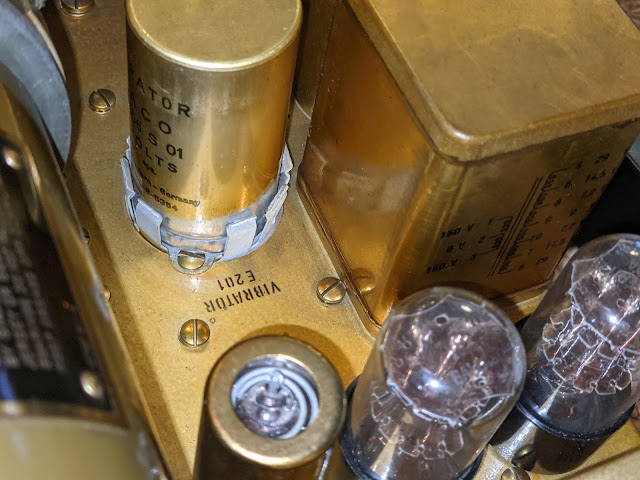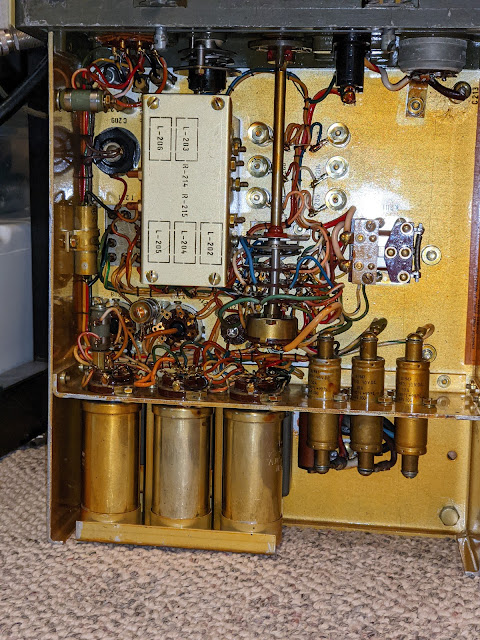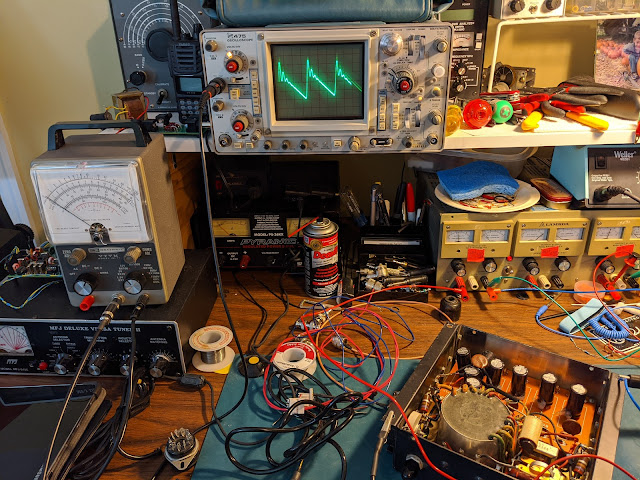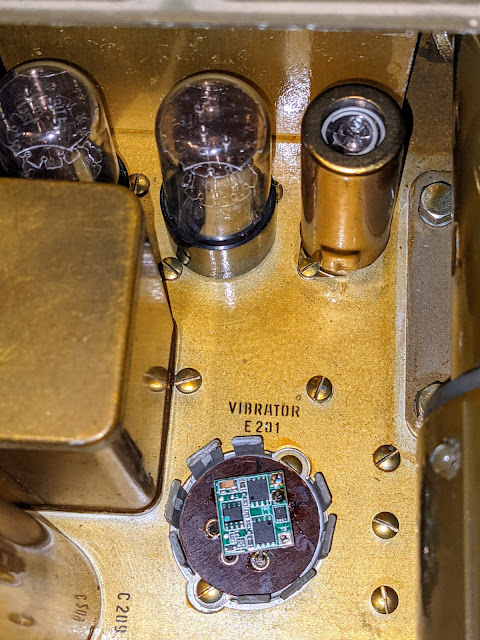 Modernizing the DY-88 Power Supply
Modernizing the DY-88 Power Supply
Go with a Modern Vibe
The DY-88 Power Supply is a marvelous design... for the 1940's. It could take 3 different DC input voltages (6v, 12v or 24v) and output the 2 different filament voltages (1.5v, 6.3v), plus the low and high B+ voltages (105v, 585v). It was designed to be as efficient as possible when the radio wasn't in SEND mode (receiver only) by employing a mechanical vibrator and transformer to power the low B+ 105v at about 1 amp current (when running off a 12v input).
Turning low voltage to high voltage
Prior to the DY-88, I'd restored a 1960's Heathkit HP-13, which was a mobile DC to DC power supply. It employed a multi-tap transformer and 2 transistors to create the needed low and high B+ voltages for Heathkit radios. in the case of the HP-13, the two transistors worked in tandem to collapse the magnetic field in the transformer to create high voltage DC, which was rectified and filtered for the radio.
Prior to the DY-88, I'd never heard of, or encountered a mechanical vibrator used in power supplies; so it's been an interesting learning experience for me. Vibrators were very common up until transistor revolution, for use in mobile applications where 12v needed to be transformed into much higher B+ voltages needed by hollow state equipment.
In oversimplified terms: the vibrator makes DC look like a square wave version of AC which can then be used by a transformer to raise the voltage required by the circuit, then rectified back to DC. Low voltage DC enters the Vibrator, which contains a relay that makes and breaks contact rapidly, chopping up the DC. It occurs so fast that the unit "vibrates" or buzzes.
The contacts eventually, become worn and pit making the vibrator less reliable. Additionally, military vibrators (maybe others) used a rubberized insulator that broke down over time inside the vibrator, releasing a corrosive gas that would further affect the components and essentially, "stick" the contacts on the relay together, making it difficult to get started or completely non-operational. Depending on how it the contacts "stick" the vibrator can act as a short and unpleasantness ensues.
The vibrators were intended to be disposable devices but they aren't being made anymore. What to do?
Bad Vibrations
In the case of my DY-88, when I received it the vibrator power supply refused to start but eventually, after a bit of percussive maintenance (banging) and reapplying power it started. Over the past couple of weeks it usually will start, but there are still occasions where power has to be switched off and on repeatedly to get it to start. It is obviously entering failure mode.
There is a procedure using an AC light bulb in series with the contacts to attempt to freshen a stubborn one up, but the procedure is hard on the contacts and generally only restores it for a while. It needs to be replaced, and vibrator power supplies have not been manufactured for many decades. The NOS vibrators are generally not good due to the breakdown of the materials inside over the decades rendering them bad even if they've never been used.
The solution is to replace the mechanical operation of the vibrator power supply with a solid state equivalent.
Solid State
Entering the age of the Jetsons, we have these nifty things called transistors that are excellent and making and breaking contact of DC voltages rapidly and reliably. I found a number of articles describing a solid state circuit I could build but most did not offer much in the way of circuit protection if a component upstream failed, or if the circuit itself failed. There are a lot of difficult or un-obtainable components in that DY-88 that I'd rather not have to replace due to the failure of the Vibrator Power Supply.
I read an article by a GRC-9 enthusiast from 2004 (NC6AV) on using a commercial circuit that was designed for this very purpose to replace mechanical vibrators in vintage automobile radios https://www.radionerds.com/images/c/cd/Wire_VBN-1.pdf. In the article describes the procedure for using a solid state replacement.
I purchased my solid state module from http://dodgem37.com/vibrator-conversion-module/ and ordered some high voltage diodes from antique radio supply to use in the conversion. I cut apart a non-functional vibrator module to use the phenolic 7-pin base for the VBN-1 module.
Note
The instructions for soldering the VBN-1 module are great with one exception. From the instructions:
. . . The pins are numbered 1 to 7, pin 1 is the large diameter pin on the right, and pins are counted clockwise from that pin. . . .
If you are looking at the base of the vibrator there are 2 large diameter pins. The instructions say count them from the pin on the right. That pin will be different if the large diameter pins are at the bottom rather than the top, when looking at the base. Turn the base such that the two large diameter pins are facing you and located at the top (12 o'clock position). Now the instructions will be correct. This may seem minor, but when I first read the instructions I was looking at the two large diameter pins situated in the 6 o'clock position and all the pins were off-by one.
Results
The replacement circuit works a treat, except that I can't hear the faint humming from the DY-88 now when the radio is in Receive mode. Of course that is immediately obliterated as I turn the radio to SEND and the Dynamotor leaps to noisy life.
Next step would be to JB-weld the can back to the base to restore the look, but I'm debating whether to do that. I kinda like the look of the modern mixed with vintage vibe (vibe, get it?).
That's all for now, keeping my heavyweight QRP GRC-9 rig on the air, one repair at a time.
Lower your power and raise your expectations,
AA4OO



















I had to smile for the memories, as I normally carried about a half dozen new vibrators in the service van in the 1980s. I needed them to keep the old Civil Defense-issued radios running in rural fire department apparatus.
Hi live in uk and i need to replace GY88 vibrator could you give me info where to get one please
Help–need to find valves: Amperite 10-4A any info greatly appreciated.